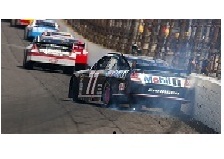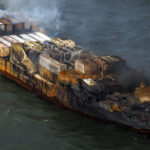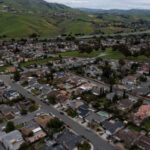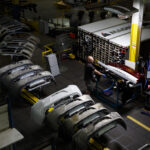Mac Demere watched the car in front of him lose control and veer left toward the inside of the track. He tried to anticipate the car’s next move, not wanting to turn until he knew where the other car was headed next.
Don’t turn until you know where to turn.
He finally swerved far to the track’s outside. But as the other car regained traction, it veered sharply to the right, directly toward Demere, and Demere’s car smashed into its right side.
“I can’t tell you what caused him to lose control,” Demere said of the 1983 crash at Watkins Glen International in upstate New York. “It happens so fast.”
Demere, now 57, walked away from that crash, but the other driver suffered a broken ankle.
Sometimes, no matter how hard you try, you crash, said Demere, a former racer from South Carolina and longtime motorsports journalist.
That certainly seemed to be the lesson at the Las Vegas Motor Speedway recently when 15 cars crashed, killing two-time Indianapolis 500 winner Dan Wheldon. He was the first IndyCar driver to die on a track since Paul Dana was killed during a practice run at Homestead-Miami Speedway in 2006.
On Oct. 16, two cars went airborne – Wheldon’s and Will Power’s. Wheldon hit a catch fence built to protect spectators from crash debris. He died later at a hospital of head injuries.
Power hit a barrier designed by the University of Nebraska-Lincoln’s Midwest Roadside Safety Facility. He walked away.
The tragically different fates of Wheldon and Power have raised concerns about the catch fence at NASCAR and IndyCar tracks and have highlighted the safety performance of the UNL-designed SAFER barrier.
Dean Sicking, director of the safety facility at UNL, said the SAFER – or Steel and Foam Energy Reduction – barriers now are in place at all NASCAR and IndyCar tracks. There have been no fatalities involving crashes into those barriers since 2004, when all of the barriers were fully installed at NASCAR tracks.
Before those barriers were installed, 1 to 1.5 drivers died each year at NASCAR tracks alone, Sicking said. In an especially cruel span of 10 months in 2000 and 2001, NASCAR crashes claimed the lives of budding stars Adam Petty, Kenny Irwin Jr. and Tony Roper, and one of the sport’s legends, Dale Earnhardt.
The trapezoidal barriers designed at UNL are made of insulation foam that is waterproof and effective at absorbing the impact of cars going well over 100 mph, Sicking said. Steel tubes serve as a barrier between the foam blocks and track. The SAFER barriers protect drivers from the unforgiving nature of concrete walls.
Sicking – whose office is decorated with a photo of him shaking hands with former President George W. Bush, as well as numerous awards – related the story of how the UNL center got the contract to design the barriers.
In 1998, Tony George, the longtime former IndyCar president and Indianapolis Motor Speedway CEO, wanted a new racetrack barrier. The concrete barriers simply weren’t good enough.
IndyCar designers had developed a new barrier made of sheets of plastic, but it broke into 50- to 100-pound chunks that littered the speedway when hit too hard. George asked the UNL center to improve the design.
“He said, ‘Can you fix this?”‘ Sicking said. “We never admit we can’t do something.”
Initially, Sicking wasn’t convinced it would be worth the extra effort. Then his assistant director, Ron Faller, convinced him it would drive the UNL center to find new solutions to road safety and new materials with which to build them.
Sicking agreed and asked George for $1 million.
“He said, ‘When can you start?”‘
It didn’t take the UNL center long to figure out the IndyCar plastic barrier would never perform as well as foam, and Sicking worked to convince a skeptical George. Finally, George relented.
In 2002, the Indianapolis Motor Speedway installed the SAFER barriers, and, seeing how well they performed, NASCAR CEO Bill France Sr. ordered them installed at all NASCAR speedways by the end of 2004 at a cost of $100 million.
The UNL center oversaw installation.
“No one can ever put it in right,” Sicking said, laughing.
The barrier has earned the UNL center numerous awards, including the prestigious 2002 Louis Schwitzer Award, presented in conjunction with the Indianapolis 500.
IndyCar senior technical director Phil Casey called SAFER barriers the greatest achievement for safety in automobile racing.
The barriers were installed at the New Hampshire Motor Speedway in 2003, and the speedway where both Petty and Irwin Jr. died has had no fatalities or serious injuries since, said speedway spokeswoman Kristen Costa.
“It’s better on impact. It moves with the vehicle,” she said.
Costa said the speedway reconfigured its catch fence in 2009 to make it safer as well. Sicking said catch fences at motorsports facilities need to be re-examined.
“The catch fence is a difficult safety issue, a tough nut to crack, but I think it can be,” he said.
Sicking said IndyCar is reluctant to invest the large amount of money required to redesign the catch fence, and NASCAR isn’t as interested in redesigning it as its cars rarely go airborne like the open-wheel Indy cars are prone to do.
While nothing has been determined, the UNL center could end up leading the investigation into the crash that killed Wheldon, as it did with the 2001 crash that killed Earnhardt, Sicking said. The UNL center has examined nearly 2,000 crashes under federal contract.
“Any time you have a big wreck, we normally get to look at it,” he said.
Demere, the former racer who now is pursuing a master’s in journalism from UNL, said it appears Wheldon tried to slow down by lifting his foot off the accelerator and tried to direct his car toward the gearbox of the slowing car in front of him. But his car’s nose lifted, and, traveling at more than 200 mph, his car quickly took to the air.
With 15 cars involved, it was simply impossible for Wheldon to avoid the carnage, Demere said.
He said drivers try not to think about getting seriously injured or killed while they’re racing. They simply try to focus on the track and the racers around them.
“We all know that it might happen to us,” he said. “Quite frankly, I’m surprised that it didn’t happen to me.”
Was this article valuable?
Here are more articles you may enjoy.

 North Sea Ship Collision Could Cost Insurers up to $100M, Hitting Marine Line Profits
North Sea Ship Collision Could Cost Insurers up to $100M, Hitting Marine Line Profits  A California City Is Pioneering Urban-Scale Insurance for Climate Disasters
A California City Is Pioneering Urban-Scale Insurance for Climate Disasters  BYD’s Five-Minute Charges Turning Heads in EV Industry
BYD’s Five-Minute Charges Turning Heads in EV Industry  Canadian Auto Parts Stocks Thrown Into a Tailspin by Tariff Woes
Canadian Auto Parts Stocks Thrown Into a Tailspin by Tariff Woes 